Leadership and Management Report: ASDA Operations and Strategies
VerifiedAdded on 2023/01/06
|16
|4358
|100
Report
AI Summary
This report analyzes leadership and management principles within the context of ASDA, a British supermarket chain. It begins by defining and comparing the roles and characteristics of leaders and managers, differentiating their responsibilities and approaches within an organizational setting. The report then examines how leadership and management functions apply in various situations, such as recruitment and performance management. Different leadership approaches, including situational, systems, and contingency leadership, are applied to ASDA's operational strategies. The report further explores key approaches to operations management, such as Total Quality Management (TQM) and Just-in-Time (JIT) methodologies, highlighting their importance in achieving business objectives. Finally, the report assesses how factors within the business environment impact operational management and decision-making by leaders and managers, providing a comprehensive overview of leadership, management, and operational strategies within the context of a real-world business case.
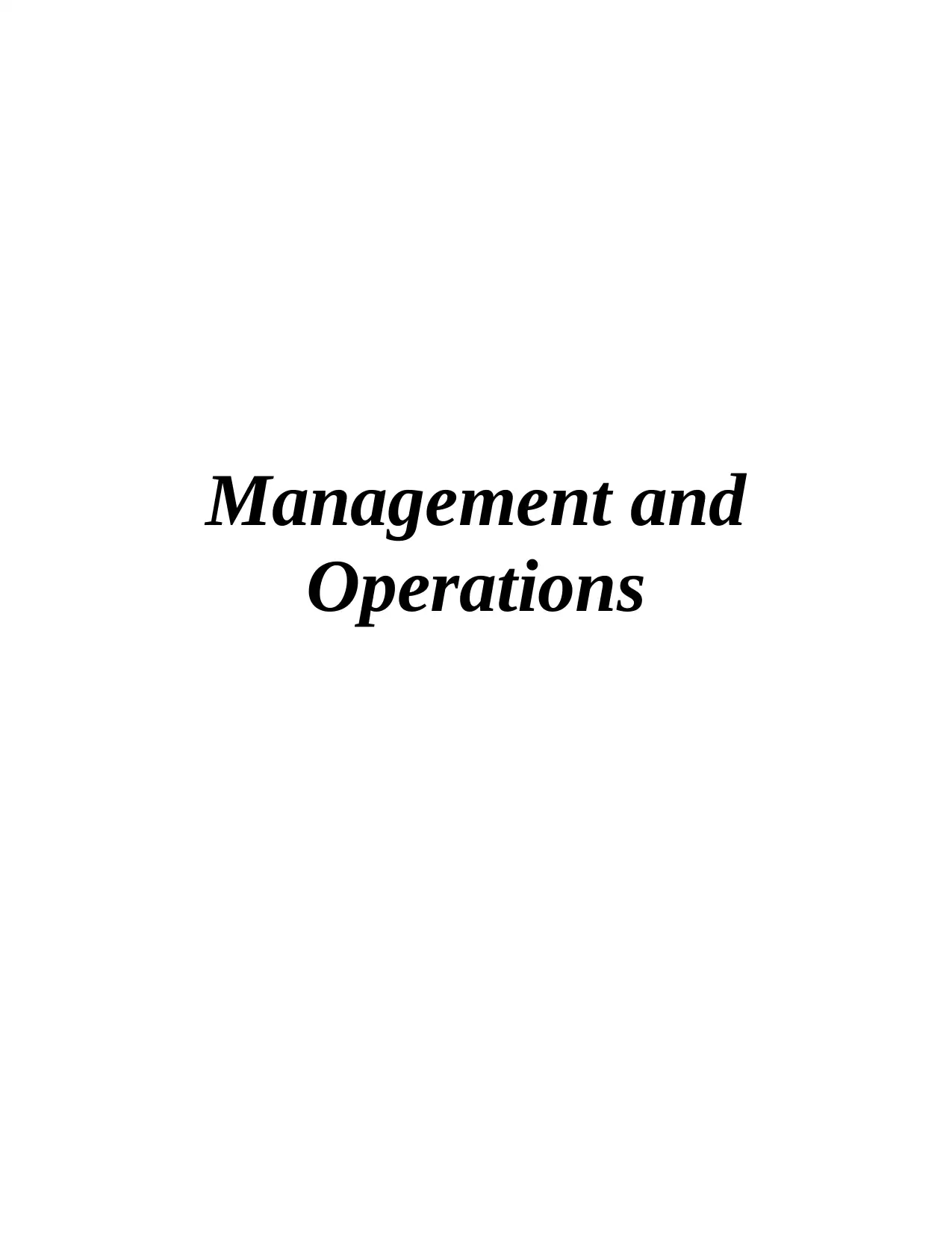
Management and
Operations
Operations
Paraphrase This Document
Need a fresh take? Get an instant paraphrase of this document with our AI Paraphraser
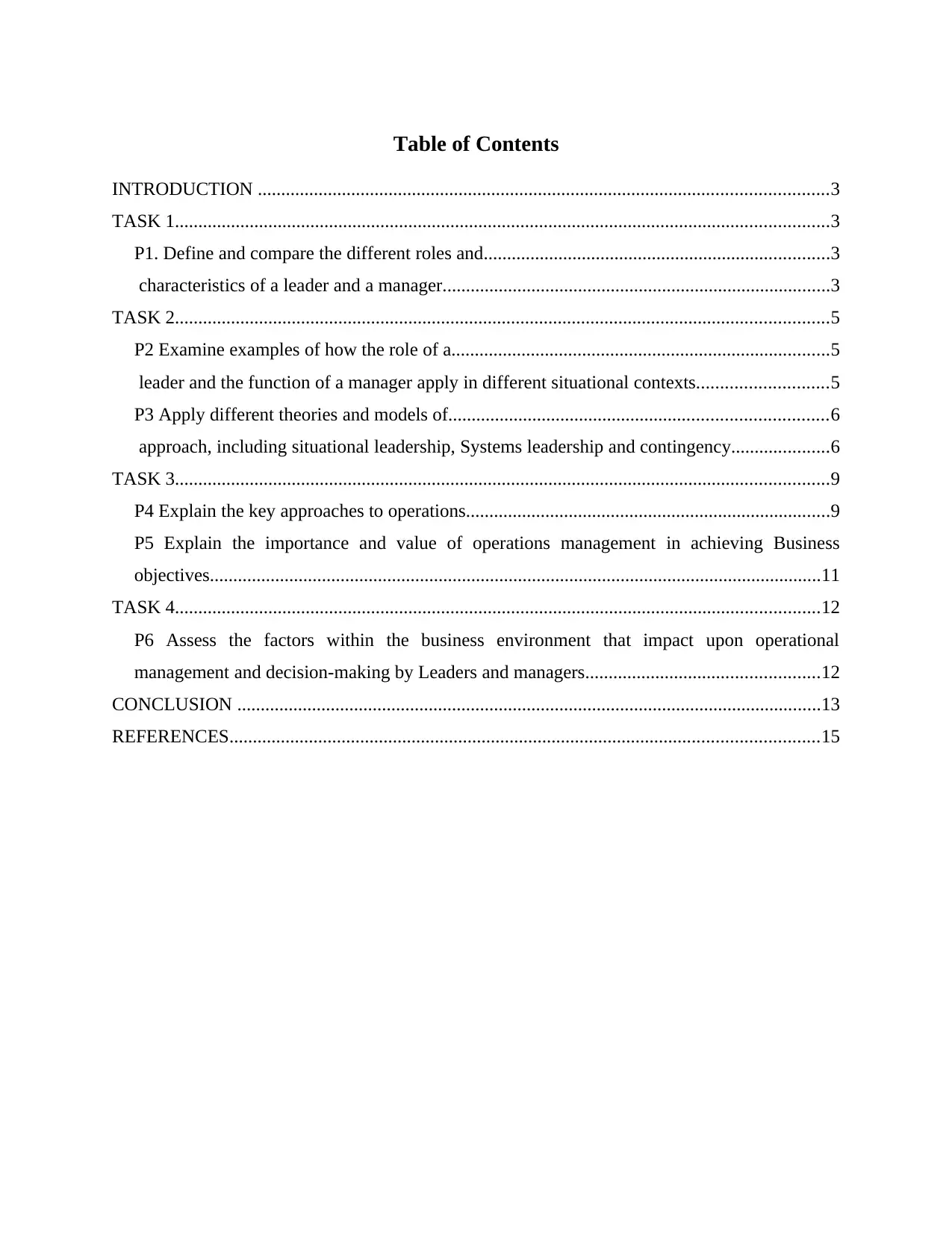
Table of Contents
INTRODUCTION ..........................................................................................................................3
TASK 1............................................................................................................................................3
P1. Define and compare the different roles and..........................................................................3
characteristics of a leader and a manager...................................................................................3
TASK 2............................................................................................................................................5
P2 Examine examples of how the role of a.................................................................................5
leader and the function of a manager apply in different situational contexts............................5
P3 Apply different theories and models of.................................................................................6
approach, including situational leadership, Systems leadership and contingency.....................6
TASK 3............................................................................................................................................9
P4 Explain the key approaches to operations..............................................................................9
P5 Explain the importance and value of operations management in achieving Business
objectives...................................................................................................................................11
TASK 4..........................................................................................................................................12
P6 Assess the factors within the business environment that impact upon operational
management and decision-making by Leaders and managers..................................................12
CONCLUSION .............................................................................................................................13
REFERENCES..............................................................................................................................15
INTRODUCTION ..........................................................................................................................3
TASK 1............................................................................................................................................3
P1. Define and compare the different roles and..........................................................................3
characteristics of a leader and a manager...................................................................................3
TASK 2............................................................................................................................................5
P2 Examine examples of how the role of a.................................................................................5
leader and the function of a manager apply in different situational contexts............................5
P3 Apply different theories and models of.................................................................................6
approach, including situational leadership, Systems leadership and contingency.....................6
TASK 3............................................................................................................................................9
P4 Explain the key approaches to operations..............................................................................9
P5 Explain the importance and value of operations management in achieving Business
objectives...................................................................................................................................11
TASK 4..........................................................................................................................................12
P6 Assess the factors within the business environment that impact upon operational
management and decision-making by Leaders and managers..................................................12
CONCLUSION .............................................................................................................................13
REFERENCES..............................................................................................................................15
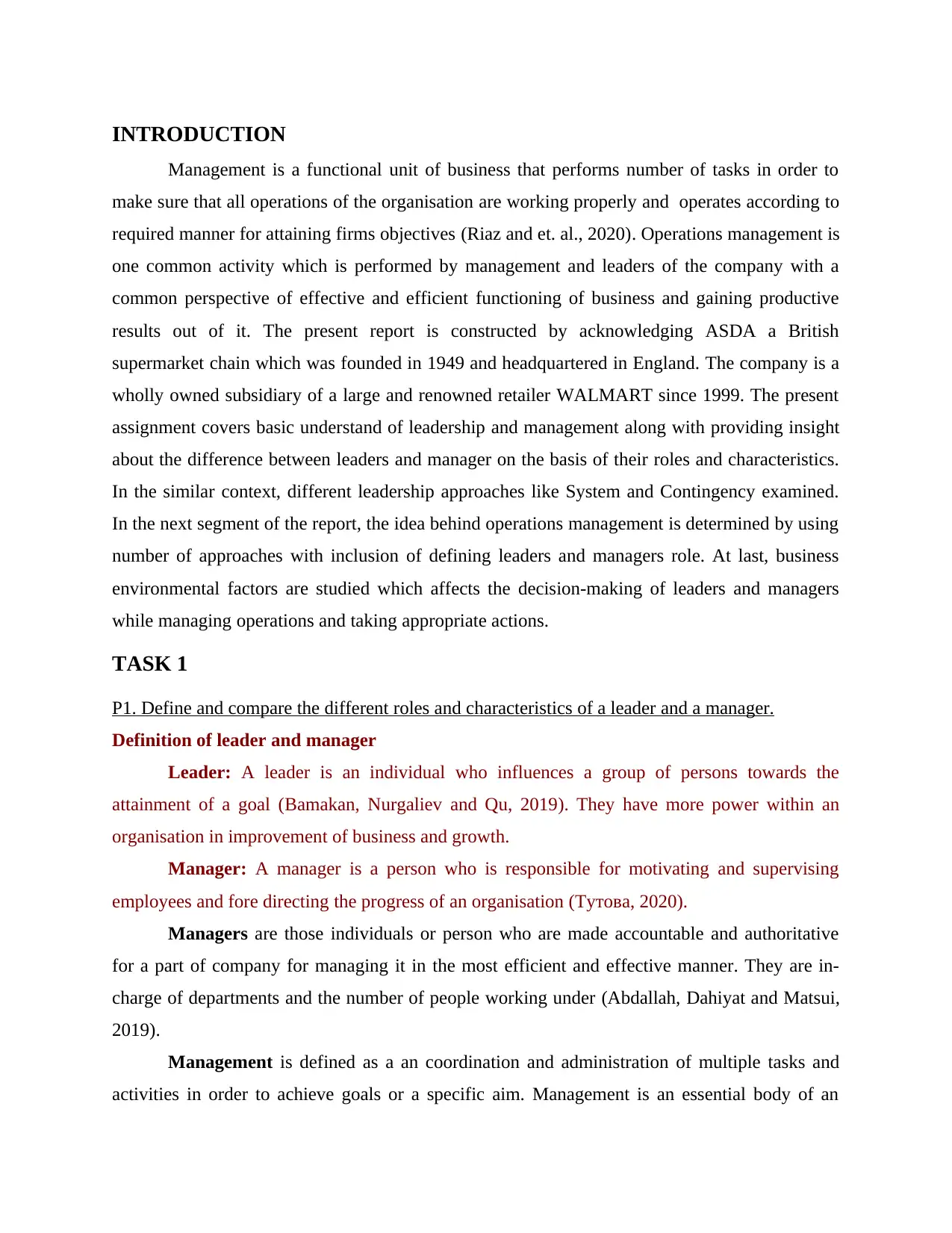
INTRODUCTION
Management is a functional unit of business that performs number of tasks in order to
make sure that all operations of the organisation are working properly and operates according to
required manner for attaining firms objectives (Riaz and et. al., 2020). Operations management is
one common activity which is performed by management and leaders of the company with a
common perspective of effective and efficient functioning of business and gaining productive
results out of it. The present report is constructed by acknowledging ASDA a British
supermarket chain which was founded in 1949 and headquartered in England. The company is a
wholly owned subsidiary of a large and renowned retailer WALMART since 1999. The present
assignment covers basic understand of leadership and management along with providing insight
about the difference between leaders and manager on the basis of their roles and characteristics.
In the similar context, different leadership approaches like System and Contingency examined.
In the next segment of the report, the idea behind operations management is determined by using
number of approaches with inclusion of defining leaders and managers role. At last, business
environmental factors are studied which affects the decision-making of leaders and managers
while managing operations and taking appropriate actions.
TASK 1
P1. Define and compare the different roles and characteristics of a leader and a manager.
Definition of leader and manager
Leader: A leader is an individual who influences a group of persons towards the
attainment of a goal (Bamakan, Nurgaliev and Qu, 2019). They have more power within an
organisation in improvement of business and growth.
Manager: A manager is a person who is responsible for motivating and supervising
employees and fore directing the progress of an organisation (Тутова, 2020).
Managers are those individuals or person who are made accountable and authoritative
for a part of company for managing it in the most efficient and effective manner. They are in-
charge of departments and the number of people working under (Abdallah, Dahiyat and Matsui,
2019).
Management is defined as a an coordination and administration of multiple tasks and
activities in order to achieve goals or a specific aim. Management is an essential body of an
Management is a functional unit of business that performs number of tasks in order to
make sure that all operations of the organisation are working properly and operates according to
required manner for attaining firms objectives (Riaz and et. al., 2020). Operations management is
one common activity which is performed by management and leaders of the company with a
common perspective of effective and efficient functioning of business and gaining productive
results out of it. The present report is constructed by acknowledging ASDA a British
supermarket chain which was founded in 1949 and headquartered in England. The company is a
wholly owned subsidiary of a large and renowned retailer WALMART since 1999. The present
assignment covers basic understand of leadership and management along with providing insight
about the difference between leaders and manager on the basis of their roles and characteristics.
In the similar context, different leadership approaches like System and Contingency examined.
In the next segment of the report, the idea behind operations management is determined by using
number of approaches with inclusion of defining leaders and managers role. At last, business
environmental factors are studied which affects the decision-making of leaders and managers
while managing operations and taking appropriate actions.
TASK 1
P1. Define and compare the different roles and characteristics of a leader and a manager.
Definition of leader and manager
Leader: A leader is an individual who influences a group of persons towards the
attainment of a goal (Bamakan, Nurgaliev and Qu, 2019). They have more power within an
organisation in improvement of business and growth.
Manager: A manager is a person who is responsible for motivating and supervising
employees and fore directing the progress of an organisation (Тутова, 2020).
Managers are those individuals or person who are made accountable and authoritative
for a part of company for managing it in the most efficient and effective manner. They are in-
charge of departments and the number of people working under (Abdallah, Dahiyat and Matsui,
2019).
Management is defined as a an coordination and administration of multiple tasks and
activities in order to achieve goals or a specific aim. Management is an essential body of an
⊘ This is a preview!⊘
Do you want full access?
Subscribe today to unlock all pages.

Trusted by 1+ million students worldwide
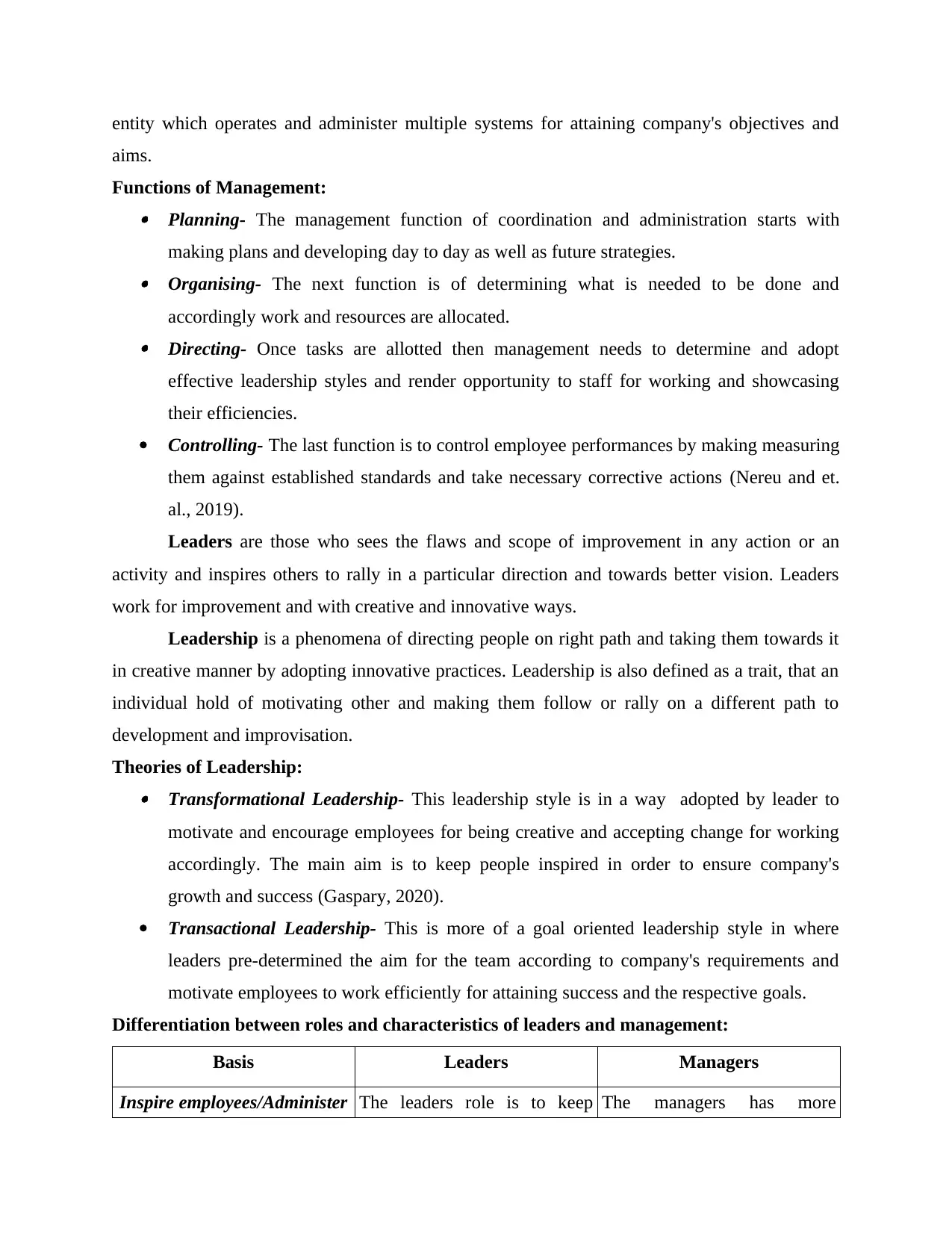
entity which operates and administer multiple systems for attaining company's objectives and
aims.
Functions of Management: Planning- The management function of coordination and administration starts with
making plans and developing day to day as well as future strategies. Organising- The next function is of determining what is needed to be done and
accordingly work and resources are allocated. Directing- Once tasks are allotted then management needs to determine and adopt
effective leadership styles and render opportunity to staff for working and showcasing
their efficiencies.
Controlling- The last function is to control employee performances by making measuring
them against established standards and take necessary corrective actions (Nereu and et.
al., 2019).
Leaders are those who sees the flaws and scope of improvement in any action or an
activity and inspires others to rally in a particular direction and towards better vision. Leaders
work for improvement and with creative and innovative ways.
Leadership is a phenomena of directing people on right path and taking them towards it
in creative manner by adopting innovative practices. Leadership is also defined as a trait, that an
individual hold of motivating other and making them follow or rally on a different path to
development and improvisation.
Theories of Leadership: Transformational Leadership- This leadership style is in a way adopted by leader to
motivate and encourage employees for being creative and accepting change for working
accordingly. The main aim is to keep people inspired in order to ensure company's
growth and success (Gaspary, 2020).
Transactional Leadership- This is more of a goal oriented leadership style in where
leaders pre-determined the aim for the team according to company's requirements and
motivate employees to work efficiently for attaining success and the respective goals.
Differentiation between roles and characteristics of leaders and management:
Basis Leaders Managers
Inspire employees/Administer The leaders role is to keep The managers has more
aims.
Functions of Management: Planning- The management function of coordination and administration starts with
making plans and developing day to day as well as future strategies. Organising- The next function is of determining what is needed to be done and
accordingly work and resources are allocated. Directing- Once tasks are allotted then management needs to determine and adopt
effective leadership styles and render opportunity to staff for working and showcasing
their efficiencies.
Controlling- The last function is to control employee performances by making measuring
them against established standards and take necessary corrective actions (Nereu and et.
al., 2019).
Leaders are those who sees the flaws and scope of improvement in any action or an
activity and inspires others to rally in a particular direction and towards better vision. Leaders
work for improvement and with creative and innovative ways.
Leadership is a phenomena of directing people on right path and taking them towards it
in creative manner by adopting innovative practices. Leadership is also defined as a trait, that an
individual hold of motivating other and making them follow or rally on a different path to
development and improvisation.
Theories of Leadership: Transformational Leadership- This leadership style is in a way adopted by leader to
motivate and encourage employees for being creative and accepting change for working
accordingly. The main aim is to keep people inspired in order to ensure company's
growth and success (Gaspary, 2020).
Transactional Leadership- This is more of a goal oriented leadership style in where
leaders pre-determined the aim for the team according to company's requirements and
motivate employees to work efficiently for attaining success and the respective goals.
Differentiation between roles and characteristics of leaders and management:
Basis Leaders Managers
Inspire employees/Administer The leaders role is to keep The managers has more
Paraphrase This Document
Need a fresh take? Get an instant paraphrase of this document with our AI Paraphraser
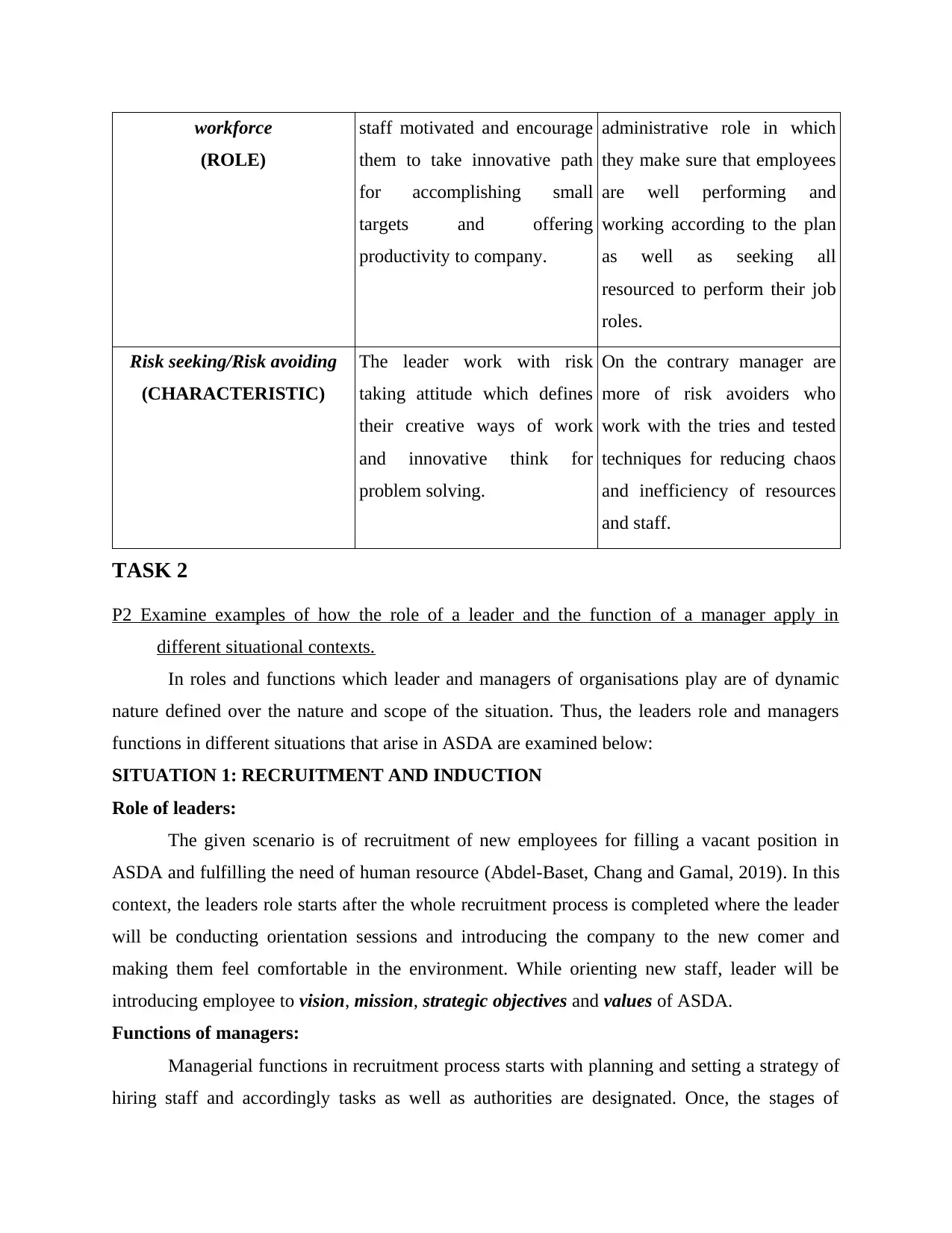
workforce
(ROLE)
staff motivated and encourage
them to take innovative path
for accomplishing small
targets and offering
productivity to company.
administrative role in which
they make sure that employees
are well performing and
working according to the plan
as well as seeking all
resourced to perform their job
roles.
Risk seeking/Risk avoiding
(CHARACTERISTIC)
The leader work with risk
taking attitude which defines
their creative ways of work
and innovative think for
problem solving.
On the contrary manager are
more of risk avoiders who
work with the tries and tested
techniques for reducing chaos
and inefficiency of resources
and staff.
TASK 2
P2 Examine examples of how the role of a leader and the function of a manager apply in
different situational contexts.
In roles and functions which leader and managers of organisations play are of dynamic
nature defined over the nature and scope of the situation. Thus, the leaders role and managers
functions in different situations that arise in ASDA are examined below:
SITUATION 1: RECRUITMENT AND INDUCTION
Role of leaders:
The given scenario is of recruitment of new employees for filling a vacant position in
ASDA and fulfilling the need of human resource (Abdel-Baset, Chang and Gamal, 2019). In this
context, the leaders role starts after the whole recruitment process is completed where the leader
will be conducting orientation sessions and introducing the company to the new comer and
making them feel comfortable in the environment. While orienting new staff, leader will be
introducing employee to vision, mission, strategic objectives and values of ASDA.
Functions of managers:
Managerial functions in recruitment process starts with planning and setting a strategy of
hiring staff and accordingly tasks as well as authorities are designated. Once, the stages of
(ROLE)
staff motivated and encourage
them to take innovative path
for accomplishing small
targets and offering
productivity to company.
administrative role in which
they make sure that employees
are well performing and
working according to the plan
as well as seeking all
resourced to perform their job
roles.
Risk seeking/Risk avoiding
(CHARACTERISTIC)
The leader work with risk
taking attitude which defines
their creative ways of work
and innovative think for
problem solving.
On the contrary manager are
more of risk avoiders who
work with the tries and tested
techniques for reducing chaos
and inefficiency of resources
and staff.
TASK 2
P2 Examine examples of how the role of a leader and the function of a manager apply in
different situational contexts.
In roles and functions which leader and managers of organisations play are of dynamic
nature defined over the nature and scope of the situation. Thus, the leaders role and managers
functions in different situations that arise in ASDA are examined below:
SITUATION 1: RECRUITMENT AND INDUCTION
Role of leaders:
The given scenario is of recruitment of new employees for filling a vacant position in
ASDA and fulfilling the need of human resource (Abdel-Baset, Chang and Gamal, 2019). In this
context, the leaders role starts after the whole recruitment process is completed where the leader
will be conducting orientation sessions and introducing the company to the new comer and
making them feel comfortable in the environment. While orienting new staff, leader will be
introducing employee to vision, mission, strategic objectives and values of ASDA.
Functions of managers:
Managerial functions in recruitment process starts with planning and setting a strategy of
hiring staff and accordingly tasks as well as authorities are designated. Once, the stages of
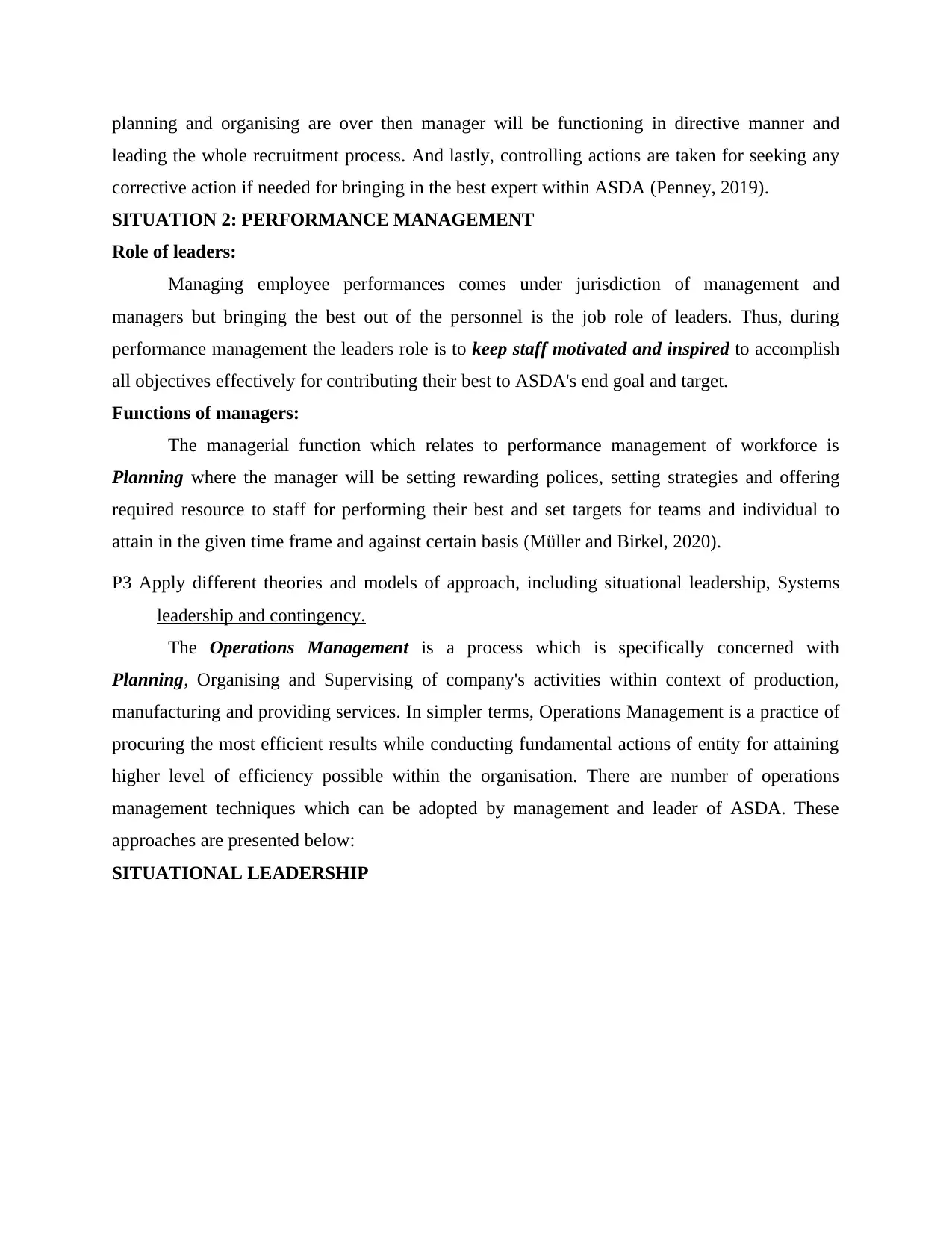
planning and organising are over then manager will be functioning in directive manner and
leading the whole recruitment process. And lastly, controlling actions are taken for seeking any
corrective action if needed for bringing in the best expert within ASDA (Penney, 2019).
SITUATION 2: PERFORMANCE MANAGEMENT
Role of leaders:
Managing employee performances comes under jurisdiction of management and
managers but bringing the best out of the personnel is the job role of leaders. Thus, during
performance management the leaders role is to keep staff motivated and inspired to accomplish
all objectives effectively for contributing their best to ASDA's end goal and target.
Functions of managers:
The managerial function which relates to performance management of workforce is
Planning where the manager will be setting rewarding polices, setting strategies and offering
required resource to staff for performing their best and set targets for teams and individual to
attain in the given time frame and against certain basis (Müller and Birkel, 2020).
P3 Apply different theories and models of approach, including situational leadership, Systems
leadership and contingency.
The Operations Management is a process which is specifically concerned with
Planning, Organising and Supervising of company's activities within context of production,
manufacturing and providing services. In simpler terms, Operations Management is a practice of
procuring the most efficient results while conducting fundamental actions of entity for attaining
higher level of efficiency possible within the organisation. There are number of operations
management techniques which can be adopted by management and leader of ASDA. These
approaches are presented below:
SITUATIONAL LEADERSHIP
leading the whole recruitment process. And lastly, controlling actions are taken for seeking any
corrective action if needed for bringing in the best expert within ASDA (Penney, 2019).
SITUATION 2: PERFORMANCE MANAGEMENT
Role of leaders:
Managing employee performances comes under jurisdiction of management and
managers but bringing the best out of the personnel is the job role of leaders. Thus, during
performance management the leaders role is to keep staff motivated and inspired to accomplish
all objectives effectively for contributing their best to ASDA's end goal and target.
Functions of managers:
The managerial function which relates to performance management of workforce is
Planning where the manager will be setting rewarding polices, setting strategies and offering
required resource to staff for performing their best and set targets for teams and individual to
attain in the given time frame and against certain basis (Müller and Birkel, 2020).
P3 Apply different theories and models of approach, including situational leadership, Systems
leadership and contingency.
The Operations Management is a process which is specifically concerned with
Planning, Organising and Supervising of company's activities within context of production,
manufacturing and providing services. In simpler terms, Operations Management is a practice of
procuring the most efficient results while conducting fundamental actions of entity for attaining
higher level of efficiency possible within the organisation. There are number of operations
management techniques which can be adopted by management and leader of ASDA. These
approaches are presented below:
SITUATIONAL LEADERSHIP
⊘ This is a preview!⊘
Do you want full access?
Subscribe today to unlock all pages.

Trusted by 1+ million students worldwide
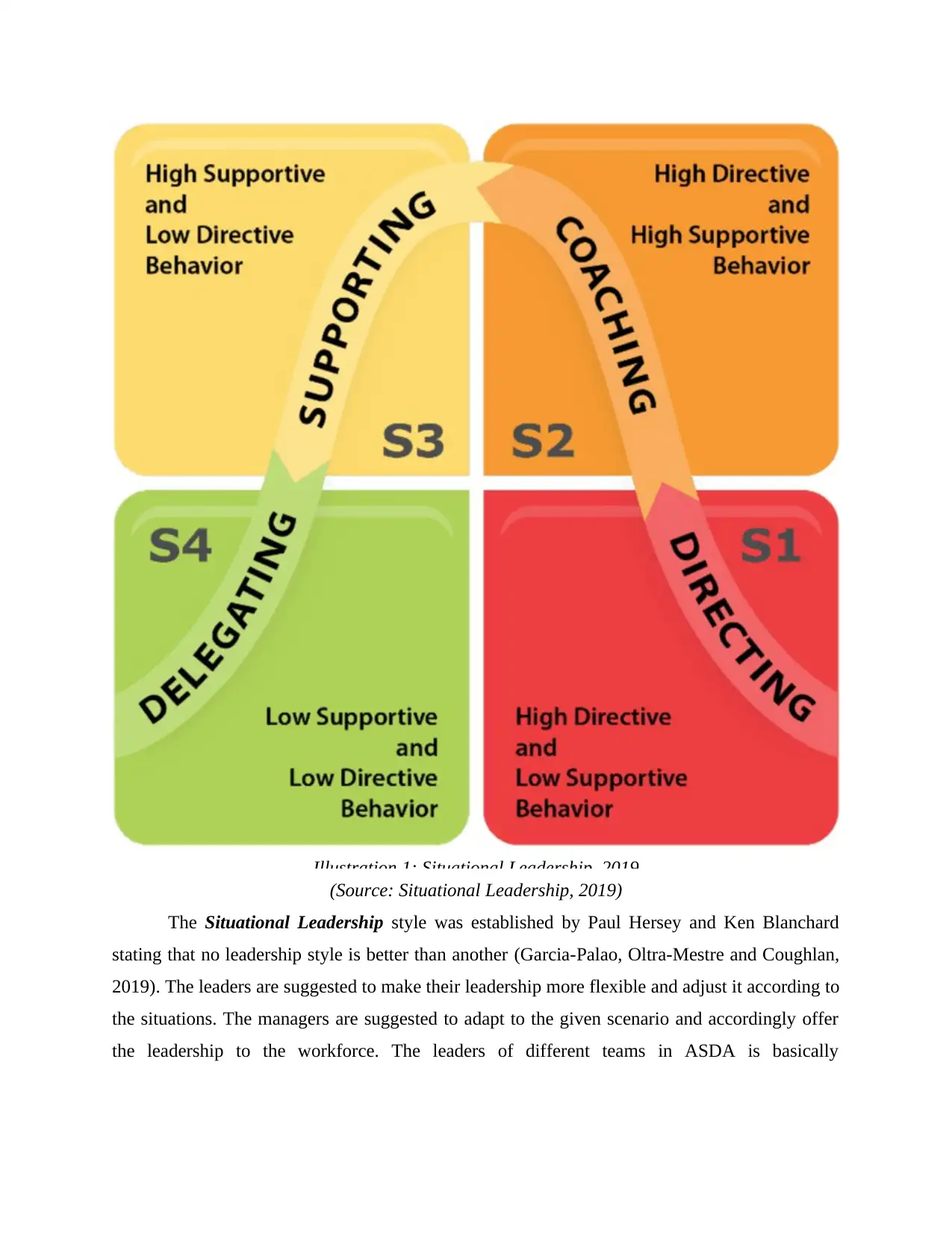
(Source: Situational Leadership, 2019)
The Situational Leadership style was established by Paul Hersey and Ken Blanchard
stating that no leadership style is better than another (Garcia-Palao, Oltra-Mestre and Coughlan,
2019). The leaders are suggested to make their leadership more flexible and adjust it according to
the situations. The managers are suggested to adapt to the given scenario and accordingly offer
the leadership to the workforce. The leaders of different teams in ASDA is basically
Illustration 1: Situational Leadership, 2019
The Situational Leadership style was established by Paul Hersey and Ken Blanchard
stating that no leadership style is better than another (Garcia-Palao, Oltra-Mestre and Coughlan,
2019). The leaders are suggested to make their leadership more flexible and adjust it according to
the situations. The managers are suggested to adapt to the given scenario and accordingly offer
the leadership to the workforce. The leaders of different teams in ASDA is basically
Illustration 1: Situational Leadership, 2019
Paraphrase This Document
Need a fresh take? Get an instant paraphrase of this document with our AI Paraphraser
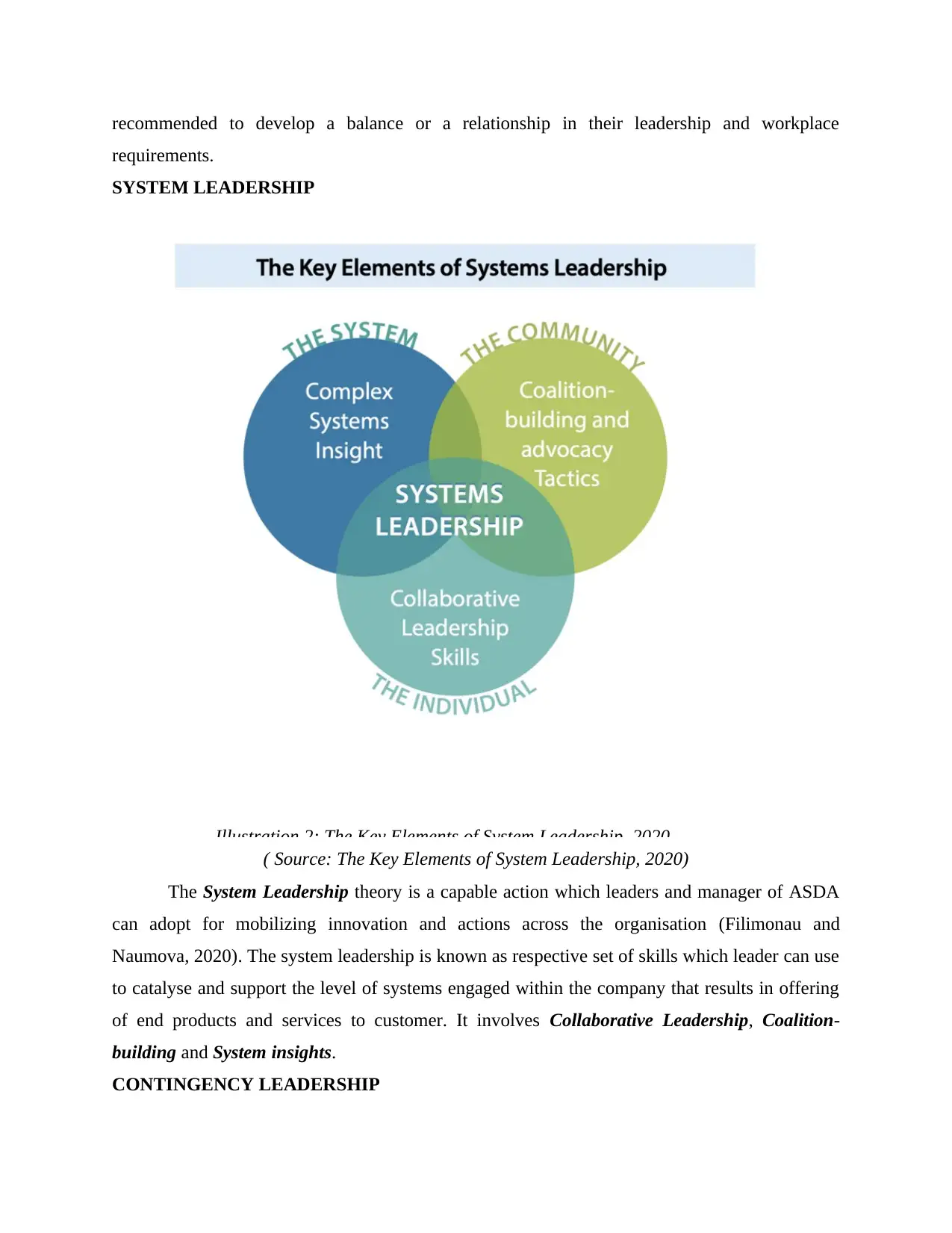
recommended to develop a balance or a relationship in their leadership and workplace
requirements.
SYSTEM LEADERSHIP
Illustration 2: The Key Elements of System Leadership, 2020
( Source: The Key Elements of System Leadership, 2020)
The System Leadership theory is a capable action which leaders and manager of ASDA
can adopt for mobilizing innovation and actions across the organisation (Filimonau and
Naumova, 2020). The system leadership is known as respective set of skills which leader can use
to catalyse and support the level of systems engaged within the company that results in offering
of end products and services to customer. It involves Collaborative Leadership, Coalition-
building and System insights.
CONTINGENCY LEADERSHIP
requirements.
SYSTEM LEADERSHIP
Illustration 2: The Key Elements of System Leadership, 2020
( Source: The Key Elements of System Leadership, 2020)
The System Leadership theory is a capable action which leaders and manager of ASDA
can adopt for mobilizing innovation and actions across the organisation (Filimonau and
Naumova, 2020). The system leadership is known as respective set of skills which leader can use
to catalyse and support the level of systems engaged within the company that results in offering
of end products and services to customer. It involves Collaborative Leadership, Coalition-
building and System insights.
CONTINGENCY LEADERSHIP
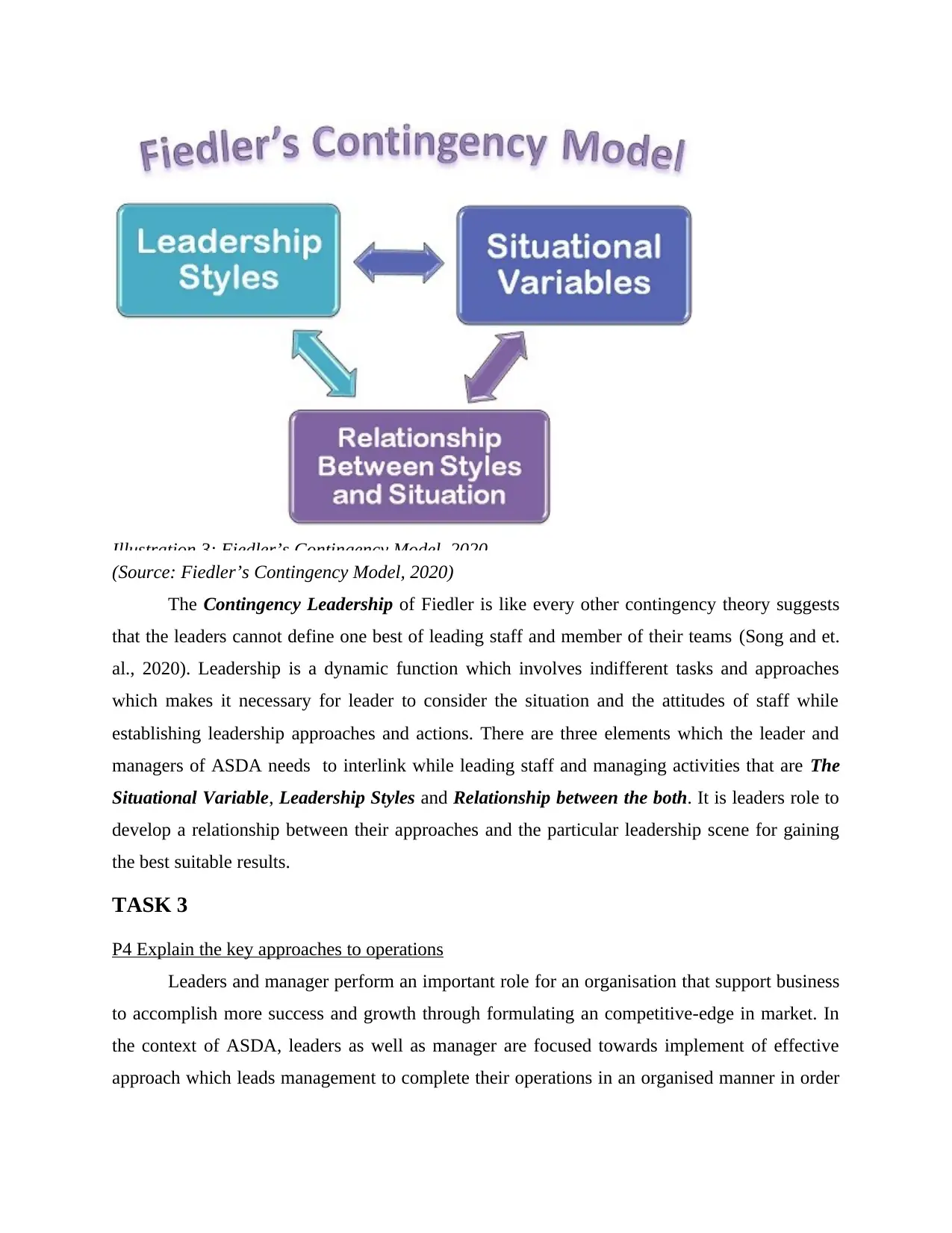
Illustration 3: Fiedler’s Contingency Model, 2020
(Source: Fiedler’s Contingency Model, 2020)
The Contingency Leadership of Fiedler is like every other contingency theory suggests
that the leaders cannot define one best of leading staff and member of their teams (Song and et.
al., 2020). Leadership is a dynamic function which involves indifferent tasks and approaches
which makes it necessary for leader to consider the situation and the attitudes of staff while
establishing leadership approaches and actions. There are three elements which the leader and
managers of ASDA needs to interlink while leading staff and managing activities that are The
Situational Variable, Leadership Styles and Relationship between the both. It is leaders role to
develop a relationship between their approaches and the particular leadership scene for gaining
the best suitable results.
TASK 3
P4 Explain the key approaches to operations
Leaders and manager perform an important role for an organisation that support business
to accomplish more success and growth through formulating an competitive-edge in market. In
the context of ASDA, leaders as well as manager are focused towards implement of effective
approach which leads management to complete their operations in an organised manner in order
(Source: Fiedler’s Contingency Model, 2020)
The Contingency Leadership of Fiedler is like every other contingency theory suggests
that the leaders cannot define one best of leading staff and member of their teams (Song and et.
al., 2020). Leadership is a dynamic function which involves indifferent tasks and approaches
which makes it necessary for leader to consider the situation and the attitudes of staff while
establishing leadership approaches and actions. There are three elements which the leader and
managers of ASDA needs to interlink while leading staff and managing activities that are The
Situational Variable, Leadership Styles and Relationship between the both. It is leaders role to
develop a relationship between their approaches and the particular leadership scene for gaining
the best suitable results.
TASK 3
P4 Explain the key approaches to operations
Leaders and manager perform an important role for an organisation that support business
to accomplish more success and growth through formulating an competitive-edge in market. In
the context of ASDA, leaders as well as manager are focused towards implement of effective
approach which leads management to complete their operations in an organised manner in order
⊘ This is a preview!⊘
Do you want full access?
Subscribe today to unlock all pages.

Trusted by 1+ million students worldwide
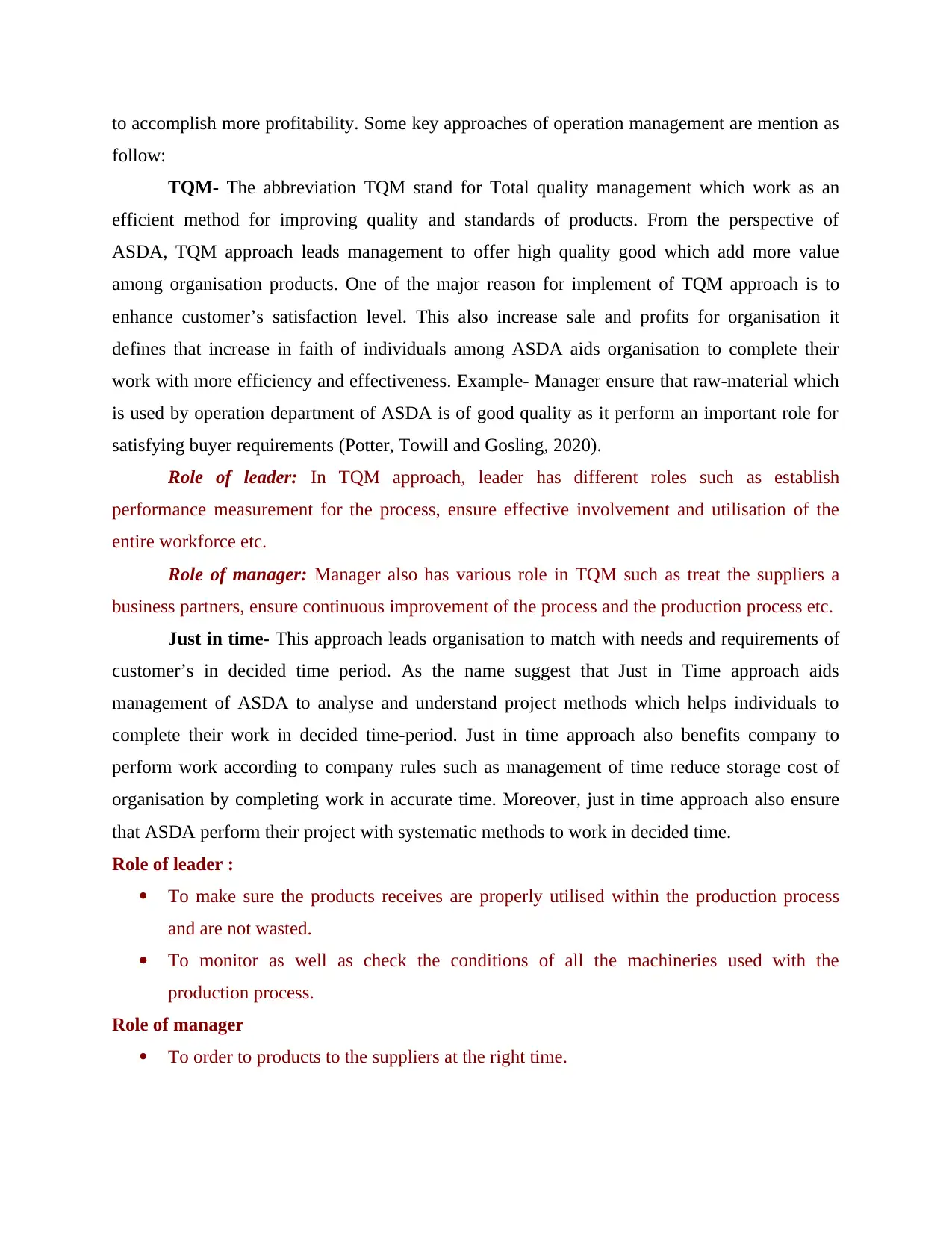
to accomplish more profitability. Some key approaches of operation management are mention as
follow:
TQM- The abbreviation TQM stand for Total quality management which work as an
efficient method for improving quality and standards of products. From the perspective of
ASDA, TQM approach leads management to offer high quality good which add more value
among organisation products. One of the major reason for implement of TQM approach is to
enhance customer’s satisfaction level. This also increase sale and profits for organisation it
defines that increase in faith of individuals among ASDA aids organisation to complete their
work with more efficiency and effectiveness. Example- Manager ensure that raw-material which
is used by operation department of ASDA is of good quality as it perform an important role for
satisfying buyer requirements (Potter, Towill and Gosling, 2020).
Role of leader: In TQM approach, leader has different roles such as establish
performance measurement for the process, ensure effective involvement and utilisation of the
entire workforce etc.
Role of manager: Manager also has various role in TQM such as treat the suppliers a
business partners, ensure continuous improvement of the process and the production process etc.
Just in time- This approach leads organisation to match with needs and requirements of
customer’s in decided time period. As the name suggest that Just in Time approach aids
management of ASDA to analyse and understand project methods which helps individuals to
complete their work in decided time-period. Just in time approach also benefits company to
perform work according to company rules such as management of time reduce storage cost of
organisation by completing work in accurate time. Moreover, just in time approach also ensure
that ASDA perform their project with systematic methods to work in decided time.
Role of leader :
To make sure the products receives are properly utilised within the production process
and are not wasted.
To monitor as well as check the conditions of all the machineries used with the
production process.
Role of manager
To order to products to the suppliers at the right time.
follow:
TQM- The abbreviation TQM stand for Total quality management which work as an
efficient method for improving quality and standards of products. From the perspective of
ASDA, TQM approach leads management to offer high quality good which add more value
among organisation products. One of the major reason for implement of TQM approach is to
enhance customer’s satisfaction level. This also increase sale and profits for organisation it
defines that increase in faith of individuals among ASDA aids organisation to complete their
work with more efficiency and effectiveness. Example- Manager ensure that raw-material which
is used by operation department of ASDA is of good quality as it perform an important role for
satisfying buyer requirements (Potter, Towill and Gosling, 2020).
Role of leader: In TQM approach, leader has different roles such as establish
performance measurement for the process, ensure effective involvement and utilisation of the
entire workforce etc.
Role of manager: Manager also has various role in TQM such as treat the suppliers a
business partners, ensure continuous improvement of the process and the production process etc.
Just in time- This approach leads organisation to match with needs and requirements of
customer’s in decided time period. As the name suggest that Just in Time approach aids
management of ASDA to analyse and understand project methods which helps individuals to
complete their work in decided time-period. Just in time approach also benefits company to
perform work according to company rules such as management of time reduce storage cost of
organisation by completing work in accurate time. Moreover, just in time approach also ensure
that ASDA perform their project with systematic methods to work in decided time.
Role of leader :
To make sure the products receives are properly utilised within the production process
and are not wasted.
To monitor as well as check the conditions of all the machineries used with the
production process.
Role of manager
To order to products to the suppliers at the right time.
Paraphrase This Document
Need a fresh take? Get an instant paraphrase of this document with our AI Paraphraser
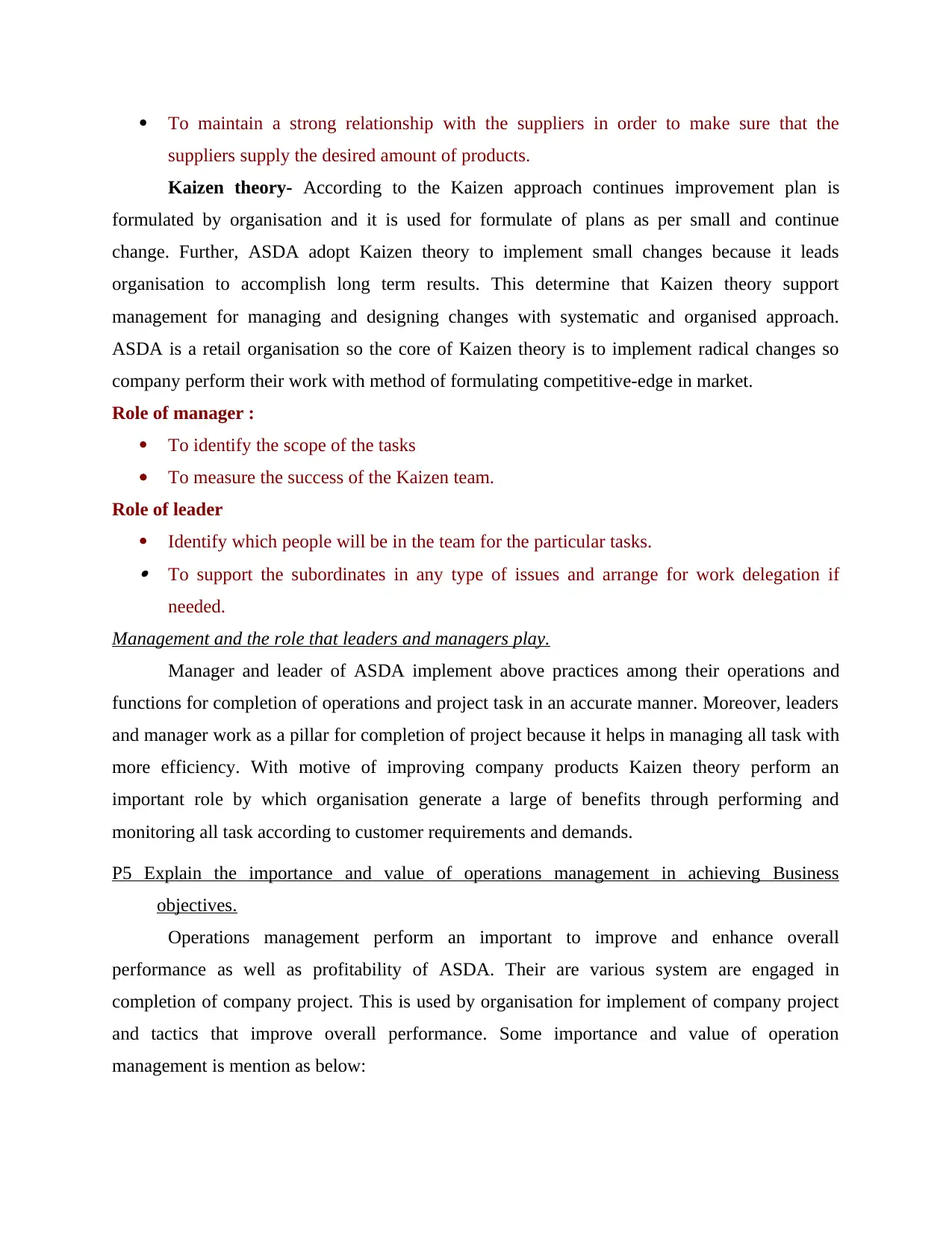
To maintain a strong relationship with the suppliers in order to make sure that the
suppliers supply the desired amount of products.
Kaizen theory- According to the Kaizen approach continues improvement plan is
formulated by organisation and it is used for formulate of plans as per small and continue
change. Further, ASDA adopt Kaizen theory to implement small changes because it leads
organisation to accomplish long term results. This determine that Kaizen theory support
management for managing and designing changes with systematic and organised approach.
ASDA is a retail organisation so the core of Kaizen theory is to implement radical changes so
company perform their work with method of formulating competitive-edge in market.
Role of manager :
To identify the scope of the tasks
To measure the success of the Kaizen team.
Role of leader
Identify which people will be in the team for the particular tasks. To support the subordinates in any type of issues and arrange for work delegation if
needed.
Management and the role that leaders and managers play.
Manager and leader of ASDA implement above practices among their operations and
functions for completion of operations and project task in an accurate manner. Moreover, leaders
and manager work as a pillar for completion of project because it helps in managing all task with
more efficiency. With motive of improving company products Kaizen theory perform an
important role by which organisation generate a large of benefits through performing and
monitoring all task according to customer requirements and demands.
P5 Explain the importance and value of operations management in achieving Business
objectives.
Operations management perform an important to improve and enhance overall
performance as well as profitability of ASDA. Their are various system are engaged in
completion of company project. This is used by organisation for implement of company project
and tactics that improve overall performance. Some importance and value of operation
management is mention as below:
suppliers supply the desired amount of products.
Kaizen theory- According to the Kaizen approach continues improvement plan is
formulated by organisation and it is used for formulate of plans as per small and continue
change. Further, ASDA adopt Kaizen theory to implement small changes because it leads
organisation to accomplish long term results. This determine that Kaizen theory support
management for managing and designing changes with systematic and organised approach.
ASDA is a retail organisation so the core of Kaizen theory is to implement radical changes so
company perform their work with method of formulating competitive-edge in market.
Role of manager :
To identify the scope of the tasks
To measure the success of the Kaizen team.
Role of leader
Identify which people will be in the team for the particular tasks. To support the subordinates in any type of issues and arrange for work delegation if
needed.
Management and the role that leaders and managers play.
Manager and leader of ASDA implement above practices among their operations and
functions for completion of operations and project task in an accurate manner. Moreover, leaders
and manager work as a pillar for completion of project because it helps in managing all task with
more efficiency. With motive of improving company products Kaizen theory perform an
important role by which organisation generate a large of benefits through performing and
monitoring all task according to customer requirements and demands.
P5 Explain the importance and value of operations management in achieving Business
objectives.
Operations management perform an important to improve and enhance overall
performance as well as profitability of ASDA. Their are various system are engaged in
completion of company project. This is used by organisation for implement of company project
and tactics that improve overall performance. Some importance and value of operation
management is mention as below:
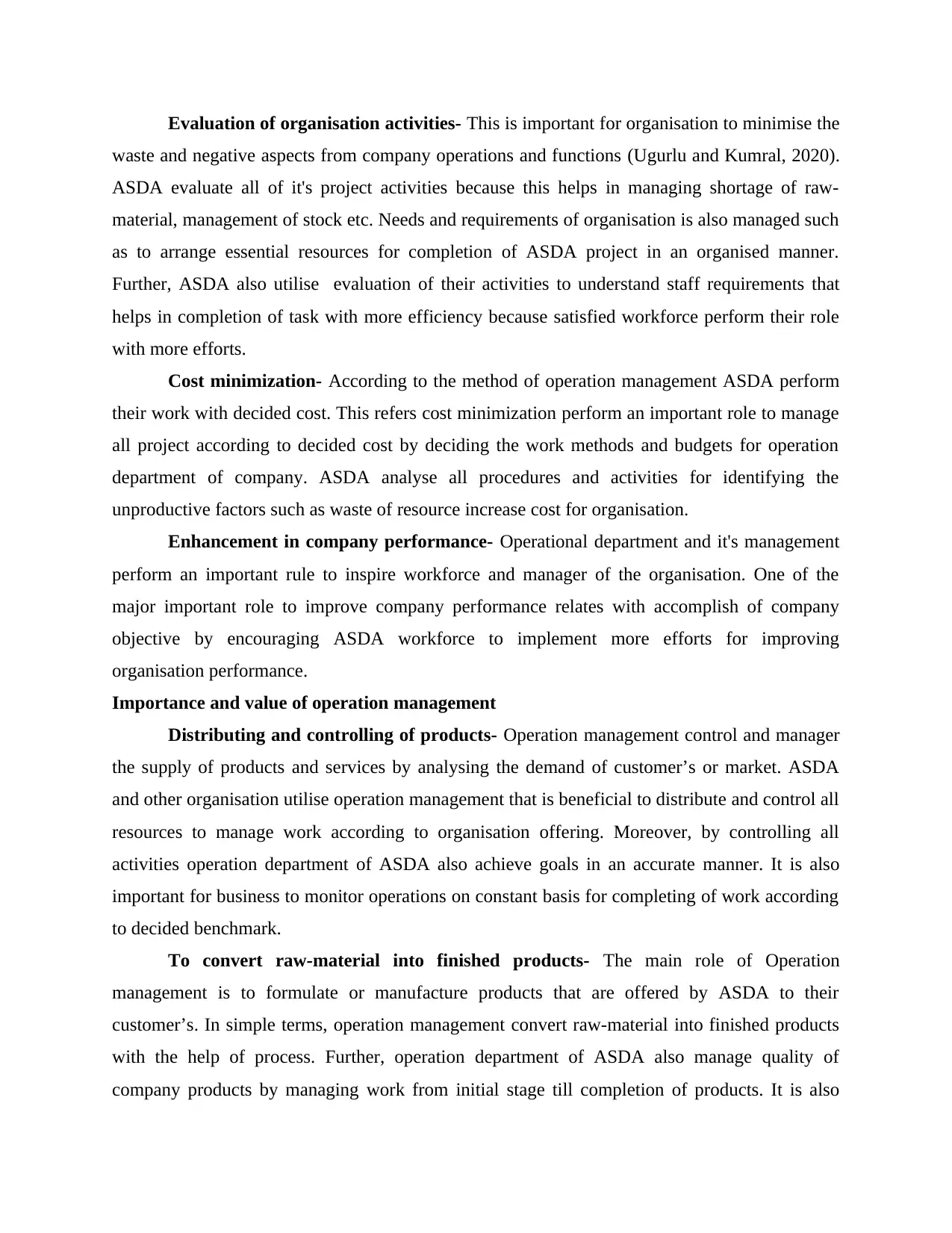
Evaluation of organisation activities- This is important for organisation to minimise the
waste and negative aspects from company operations and functions (Ugurlu and Kumral, 2020).
ASDA evaluate all of it's project activities because this helps in managing shortage of raw-
material, management of stock etc. Needs and requirements of organisation is also managed such
as to arrange essential resources for completion of ASDA project in an organised manner.
Further, ASDA also utilise evaluation of their activities to understand staff requirements that
helps in completion of task with more efficiency because satisfied workforce perform their role
with more efforts.
Cost minimization- According to the method of operation management ASDA perform
their work with decided cost. This refers cost minimization perform an important role to manage
all project according to decided cost by deciding the work methods and budgets for operation
department of company. ASDA analyse all procedures and activities for identifying the
unproductive factors such as waste of resource increase cost for organisation.
Enhancement in company performance- Operational department and it's management
perform an important rule to inspire workforce and manager of the organisation. One of the
major important role to improve company performance relates with accomplish of company
objective by encouraging ASDA workforce to implement more efforts for improving
organisation performance.
Importance and value of operation management
Distributing and controlling of products- Operation management control and manager
the supply of products and services by analysing the demand of customer’s or market. ASDA
and other organisation utilise operation management that is beneficial to distribute and control all
resources to manage work according to organisation offering. Moreover, by controlling all
activities operation department of ASDA also achieve goals in an accurate manner. It is also
important for business to monitor operations on constant basis for completing of work according
to decided benchmark.
To convert raw-material into finished products- The main role of Operation
management is to formulate or manufacture products that are offered by ASDA to their
customer’s. In simple terms, operation management convert raw-material into finished products
with the help of process. Further, operation department of ASDA also manage quality of
company products by managing work from initial stage till completion of products. It is also
waste and negative aspects from company operations and functions (Ugurlu and Kumral, 2020).
ASDA evaluate all of it's project activities because this helps in managing shortage of raw-
material, management of stock etc. Needs and requirements of organisation is also managed such
as to arrange essential resources for completion of ASDA project in an organised manner.
Further, ASDA also utilise evaluation of their activities to understand staff requirements that
helps in completion of task with more efficiency because satisfied workforce perform their role
with more efforts.
Cost minimization- According to the method of operation management ASDA perform
their work with decided cost. This refers cost minimization perform an important role to manage
all project according to decided cost by deciding the work methods and budgets for operation
department of company. ASDA analyse all procedures and activities for identifying the
unproductive factors such as waste of resource increase cost for organisation.
Enhancement in company performance- Operational department and it's management
perform an important rule to inspire workforce and manager of the organisation. One of the
major important role to improve company performance relates with accomplish of company
objective by encouraging ASDA workforce to implement more efforts for improving
organisation performance.
Importance and value of operation management
Distributing and controlling of products- Operation management control and manager
the supply of products and services by analysing the demand of customer’s or market. ASDA
and other organisation utilise operation management that is beneficial to distribute and control all
resources to manage work according to organisation offering. Moreover, by controlling all
activities operation department of ASDA also achieve goals in an accurate manner. It is also
important for business to monitor operations on constant basis for completing of work according
to decided benchmark.
To convert raw-material into finished products- The main role of Operation
management is to formulate or manufacture products that are offered by ASDA to their
customer’s. In simple terms, operation management convert raw-material into finished products
with the help of process. Further, operation department of ASDA also manage quality of
company products by managing work from initial stage till completion of products. It is also
⊘ This is a preview!⊘
Do you want full access?
Subscribe today to unlock all pages.

Trusted by 1+ million students worldwide
1 out of 16
Related Documents
Your All-in-One AI-Powered Toolkit for Academic Success.
+13062052269
info@desklib.com
Available 24*7 on WhatsApp / Email
![[object Object]](/_next/static/media/star-bottom.7253800d.svg)
Unlock your academic potential
Copyright © 2020–2025 A2Z Services. All Rights Reserved. Developed and managed by ZUCOL.





